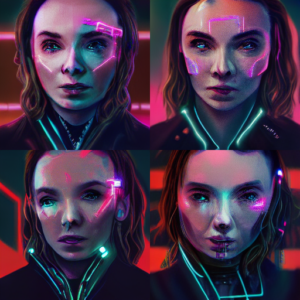The Evolution Of AI

Stepholt
News, Tips & Tricks
The Evolution Of AI
In the realm of artificial intelligence, one of the most captivating and transformative developments has been the evolution of AI-generated images. From the early pixelated attempts to today’s astonishingly realistic creations, this journey has witnessed remarkable progress. In this blog post, we’ll take a deep dive into the history, breakthroughs, and future prospects of AI-generated imagery.
The Pixelated Pioneers
The inception of AI-generated images can be traced back to the early 2000s when researchers first began experimenting with rudimentary algorithms. These early attempts primarily focused on generating pixelated, low-resolution images with limited color palettes. Neural networks were in their infancy, and computational power was a significant bottleneck.

A command we actioned 12 months ago.
The Deep Learning Revolution
The turning point came with the advent of deep learning. In 2012, AlexNet, a deep convolutional neural network, demonstrated unprecedented success in image classification tasks. This breakthrough paved the way for more complex generative models.
Generative Adversarial Networks (GANs)
One of the most influential contributions to AI-generated images has been the introduction of Generative Adversarial Networks (GANs) in 2014 by Ian Goodfellow and his team. GANs revolutionized the field by employing a two-network system—a generator and a discriminator—competing against each other. This adversarial process led to remarkably realistic outputs, demonstrating the potential for AI to create images that appeared indistinguishable from those captured by a camera.
Style Transfer and Artistic Interpretation
Another significant milestone in AI-generated imagery was the development of style transfer algorithms. This technique allowed AI to recreate images in the style of famous artists like Picasso, Van Gogh, and Monet. By analyzing the brushstrokes, colors, and patterns characteristic of each artist, AI was able to apply these styles to photographs, creating captivating and unique pieces of art.
Super-Resolution and Detail Enhancement
Advances in AI have not only focused on creating images from scratch but also on enhancing existing ones. Super-resolution algorithms, for instance, have been instrumental in upscaling low-resolution images, adding a new dimension to image processing. This has found applications in fields like satellite imaging, medical imaging, and video compression.
DeepDream and Hallucinogenic Art
Google’s DeepDream project, introduced in 2015, demonstrated a novel approach to image generation. By tweaking the internal layers of a neural network, DeepDream produced hallucinogenic and surreal images. While not practical in a conventional sense, this project showcased the creative potential of AI and inspired artists and researchers alike.
The Emergence of AI Artists
In recent years, AI has begun to take on the role of an artist, creating original works of art that evoke human emotion and provoke thought. AI-generated art pieces have even been showcased in galleries and museums around the world, blurring the lines between traditional and AI-generated art.

The same command we actioned today.
The Future: Beyond Realism
As we look ahead, the future of AI-generated images promises even more astounding developments. Research is moving towards creating images that transcend realism, delving into abstract, dreamlike, and surreal realms. Furthermore, the integration of AI with other emerging technologies like virtual reality and augmented reality opens up new frontiers in immersive visual experiences.
Conclusion
The evolution of AI-generated images has been nothing short of extraordinary. From pixelated beginnings to Picasso-esque masterpieces, the progress has been a testament to human ingenuity and technological advancement. As we forge ahead, the boundaries of what AI can achieve in the realm of imagery continue to expand, promising a future where the imagination of machines knows no bounds.
Related Posts
Ready to get started?
with over 20 years in the industry our designs, coding, and marketing services a future-proof.
Feel free to contact us today for a free site audit or to discuss your next project

